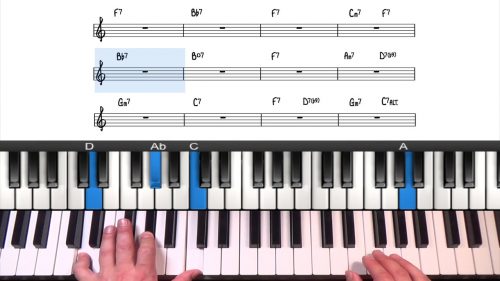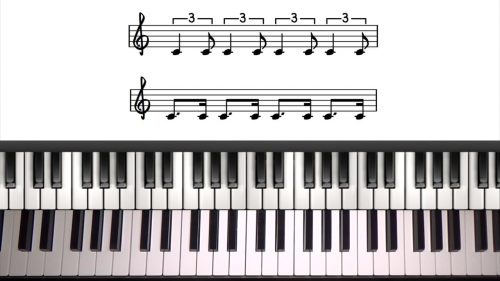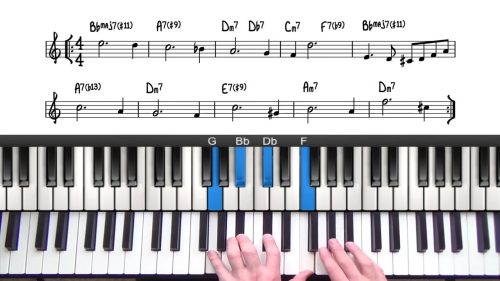Approach Patterns & Enclosures Tutorial
Now we are going to combine out knowledge of chord tone soloing with chromatic approach patterns, enclosures and non-diatonic passing tones.
This is where things will start to sound more like real jazz. I hope you have not skipped the chord tone soloing exercises because being able to visualize those tones allows you to identify the options you have available in terms of approach patterns and enclosures.
What Are Approach Patterns and Enclosures?
As we have discussed in previous lessons, the primary chord tones are very stable and consonant sounding tones. When you transition from chord to chord, if you target these tones, it will make your lines sound structured, purposeful and also in sync with the underlying harmony.
Approach patterns and enclosure can be used to enhance this. Chromatic approach patterns are particularly useful.
In the next lesson we are going to continue this type of study but focus on non-diatonic passing tones and chromaticism. You can then use this information to make more informed decisions when improvising.
Lesson Downloads
-
12 Bar Blues Lesson Supplement File Type: pdf
-
“Straight No Chaser” – Jazz Blues Form File Type: pdf
Practice Tips
-
Identify the chord tone you wish to target, then practice double enclosing the note.
-
Once you are visualising the neighbour tones, then add in a chord tone line before and after the enclosure.
-
If you want a challenge, do this for every chord tone, of ever chord type. There's 11 different chord in the jazz blues progression so that's 44 different tones to approach & enclose.
-
If you work through each one of these chords individually, enclosure each chord tone, you get a much better understanding of enclosures.
-
You will also gain an aural appreciation of what is sounds like to resolve into roots, 3rds, 5ths and 7th. They all sound different as you will find out!








Hey piano groove,
Just a question: if I’m looking to target notes for a maj7th chord. for ex: Bbmaj7th.
Would I target a F, Bb,D as the roots, but also target like A,C notes. A being the major 7th note and c the 9th. Or is it more “standard” just to try to hit the 1,3,5 of the chord?
Hey Jeff 👋
First of all, try targeting the 3rd – this is a primary chord tone and so it will always create a strong sense of resolution.
I’d recommend that you systematically work through the primary chord tone, Root (sounds nice over minor chords), 3, 5, 7, then also the extensions 9, 11 and 13. Really listen to what each one sound like and get an aural appreciation of the sound.
You can also practice landing on the different alterations over dominant chord and listen to the sound each one produces.
Now, now matter what key you are playing in, resolving in to those tones will always have the same ‘colour’ or ‘texture’ – the pitch of course will different, but resolving into the 9 of a major or minor chord for example always sounds very “sweet”. Generally, the guide tones 3 and 7 will be the most stable sounding, and then also play more of the primary chord tones afterwards to establish the chord tones in your line and to create a synergy between your left hand voicings and primary chord tones.
I actually answered a very similar question in the forum here: pianogroove.com/community/t/aiming-for-target-notes-at-end-of-improvised-line/752/5
Other great news Jeff, we are starting recording with the first guest tutor on Tuesday and currently the plan is to create another course on 12 bar blues improv.
Cheers,
Hayden
When you use double enclosure to resolve to the diatonic note of the new chord ..you decend from the Eb who is a diatonic note of F7 instead of the Db who is non diatonic. .Só you are not resolving the tension directly on the new chord…shoudnt it have a stronger impact if we decend always from the non diatonic?Minute 6.25…Só we should play the E then the Eb then the C and finally the Db to resolve to the D.Olso as a side note ..Do foi think that it is more beneficial transcribing from intruments like the sax and trumpet rather than the piano?My old teacher always told me that listening and transcribing from this intruments (think of sonny rolligs or Miles davis) are the key for incorporating swing and groove.
Só to sumárise my question….in this video you Said that we should create tension with non diatonic notes and then quicly realese the tension on a diationic note of the current chord…Só we should allways resolve from a non diatonic for getting a stronger impact ?Because in in the minute 6.25 you resolve from Eb who is a diatonic chord note of F7 (with a double enclosure)..hope it is more clear now.
Hi Ivan,
A key point is the half step approach pattern into the target chord. This is what creates the smooth transition in your lines. This half step approach can be created with both diatonic, and non-diatonic tones… as you correctly point out in your example.
Adding non diatonic tones can create a stronger sense of resolution when you finally land into the ‘stable-sounding’ chord tone of the upcoming chord.
I would recommend experimenting with both, and remember that variety is always key.
In the ‘enclosure’ examples, we use both a diatonic tone, and a non diatonic tone which can be played in either order. You can also play ‘double enclosures’ where you play 2 notes below, then 2 notes above and into the target tone. This is very commonly used if you listen to jazz recordings.
You can experiment with these concepts in the 12 bar blues form, and other common progressions such as the 251s.
Hope this helps :-)
Cheers,
Hayden
Its cool that now i can associate non diatonic with tension and diatonics with smoothness.Do you are familiar with Jacob Collier?I have wached his interviews and he always talk about his association of all his knowledge and what he want to say with that knowledge…for him learning harmony is like a language só the more you know equals more ways to say things or express things into music!Só i feel like all your teachings helps us in that…not just to play jazz only but to be better artists and express new ideas in better ways .😃😃Do you have compositions? You could teach us a original standard of yours in a special lesson.
Hey Ivan, thanks for the suggestion – i will check out his music.
I have released any compositions yet, but when I do… i will let you know ;-)
Cheers,
Hayden
Yeah you will find him interesting..he is from england too
Thanks Ivan :-)
I have a question about chord tone soloing over the Jazz blues in F. If the red notes are supposed to be chord tones, why is the D in red as it is the sixth?
Hi Arnold,
Great question.
We can see the 6th as a chord tone of the tonic chord, the tonic is F major as we are playing the blues in the key of F.
In this case the 7th can be replaced by the 6th when we create improvised melody lines.
We can also replace the 7th with the 6th in our chord voicings.
This works well with dominant chords, but not with minor chords, or -7b5 chords.
Let me know if you have any other questions here.
Cheers,
Hayden